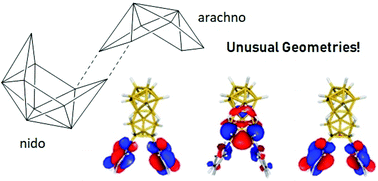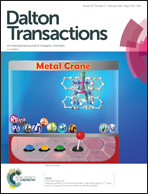Substitution of the laser borane anti-B18H22 with pyridine: a structural and photophysical study of some unusually structured macropolyhedral boron hydrides†
Abstract
Reaction of anti-B18H221 with pyridine in neutral solvents gives sparingly soluble B16H18-3′,8′-Py23a as the major product (ca. 53%) and B18H20-6′,9′-Py22 (ca. 15%) as the minor product, with small quantities of B18H20-8′-Py 4 (ca. 1%) also being formed. The three new compounds 2, 3a and 4 are characterized by single-crystal X-ray diffraction analyses and by multinuclear multiple-resonance NMR spectroscopy. Compound 2 is of ten-vertex nido:ten-vertex arachno two-atoms-in-common architecture, long postulated for a species with borons-only cluster constitution, but previously elusive. Compound 3a is of unprecedented ten-vertex nido:eight-vertex arachno two-atoms-in-common architecture. The single-crystal X-ray diffraction analysis for the picoline derivative B16H18(NC5H4Me)23b, similarly obtained, is also presented. B18H20Py 4 is also previously unreported but is of known ten-vertex nido:ten-vertex nido two-atoms-in-common architecture of anti configuration, but now with the pyridine ligand positioned differently to other reported examples of B18H20L compounds. Factors behind the remarkably low solubility of 3a and 3b are elucidated in terms of electrostatic potential (ESP) calculations, polarity, and van der Waals complementarities. In view of contemporary developing high interest in the fluorescent properties of macropolyhedral boron-containing species, a detailed assessment of the photophysical characteristics of 3a and 4 is also presented. In contrast to the thermochromic fluorescence of 2 (from 620 nm brick-red at room temperature to 585 nm yellow at 8 K, quantum yield 0.15), compound 3a is only weakly phosphorescent in the yellow region (590 nm, quantum yield 0.01), whereas compound 4 exhibits no luminescence. The far more photoactive nature of compound 2 is associated with S1 excited-state minima structures that differ from each other only by the relative rotational positions of the pyridine substituents on its disubstituted ten-vertex {arachno-B10Py2}-subcluster. The wavelength and relative intensity of fluorescence from these structures depends on the rotational positions of the pyridine ligands, which in turn are influenced by temperature and/or rotational inhibition in the solid-state.



 Please wait while we load your content...
Please wait while we load your content...